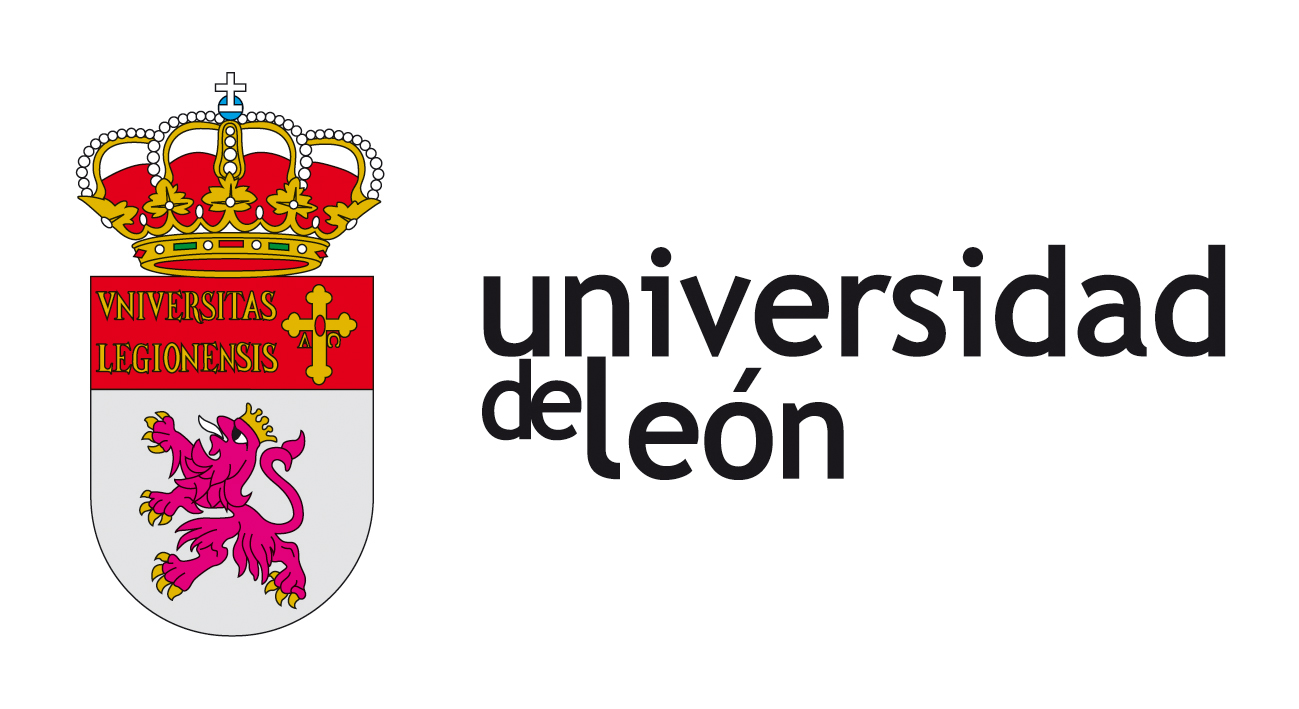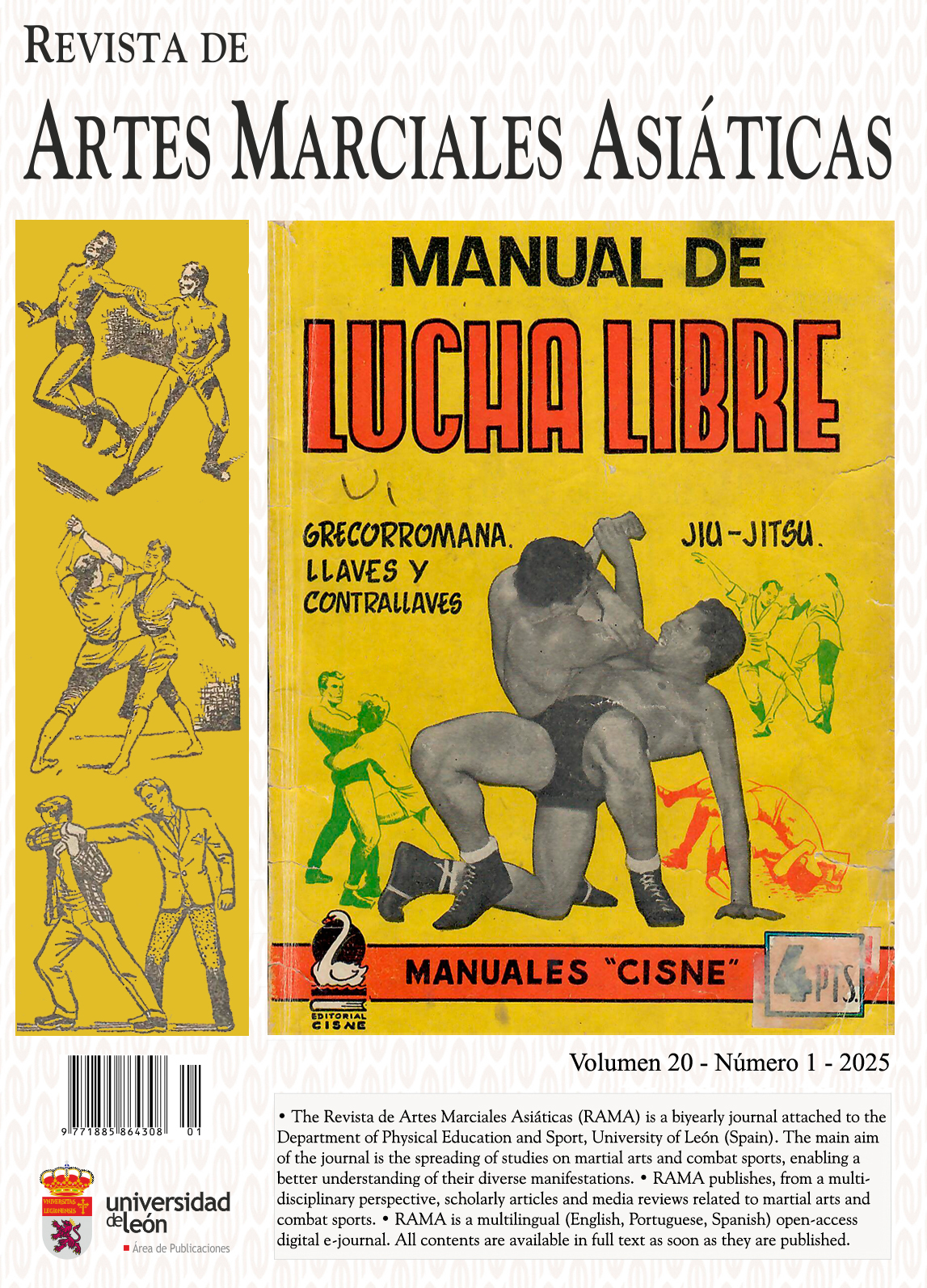Vida dentro y fuera de los clubes de combate: experiencias de artistas marciales iraníes
DOI:
https://doi.org/10.18002/rama.v20i1.2501Palabras clave:
Artes marciales, deportes de combate, kickboxing, muay thai, desarrollo del carácter, salud, bienestar, prevención de la violenciaAgencias Financiadoras:
The authors received no funding for this workResumen
Teniendo en cuenta el estilo de vida moderno, mecanizado y desarrollado en espacios interiores restringidos, la agresividad y los trastornos mentales entre jóvenes y adultos, y sus consecuencias negativas en Irán, es importante realizar estudios en profundidad sobre esta cuestión. El propósito de este artículo es comprender el significado que tienen los deportes de combate para deportistas iraníes y entender cómo dicho significado les impulsa a practicarlos. Siguiendo un enfoque de Análisis Fenomenológico Interpretativo (AFI), se realizaron entrevistas semiestructuradas a 17 practicantes de kickboxing y muay thai de la provincia de Kurdistán, al oeste de Irán. Del análisis de sus experiencias se extrajeron cuatro temas principales y 12 subtemas: (1) aumento de la capacidad existencial, (2) cultivo moral de la personalidad, (3) mejora de la propia salud y (4) mejora del propio estilo de vida. Los resultados sugieren que, para estos participantes, el kickboxing y el muay thai tienen un efecto positivo en muchas dimensiones de la existencia, a nivel mental, social y moral. Además, debido al potencial impacto positivo en el comportamiento individual, estos deportes también son muy eficaces para reducir problemas sociales como el hooliganismo, la destrucción y el vandalismo, el suicidio, el estilo de vida inadecuado, la pérdida de valores y la violencia.
Descargas
Métricas alternativas
Citas
Allahveisi, A. (2024). The ring martial arts. Hatmi Publications.
Allen, B. (2015). Striking beauty: A philosophical look at the Asian martial arts. Columbia University Press. https://doi.org/10.7312/alle17272-003
Allen‐Collinson, J. (2009). Sporting embodiment: Sports studies and the (continuing) promise of phenomenology. Qualitative Research in Sport and Exercise, 1(3), 279-296. https://doi.org/10.1080/19398440903192340
Barlow, D., & Durand, V. (2008). Psicopatologia: Uma abordagem integrada. Cengage Learning.
Brière, F. N., Rohde, P., Seeley, J. R., Klein, D., & Lewinsohn, P. M. (2015). Adolescent suicide attempts and adult adjustment. Depression and Anxiety, 32(4), 270-276. https://doi.org/10.1002/da.22296
Bu, B., Haijun, H., Yong, L., Chaohui, Z., Xiaoyuan, Y., & Singh, M. F. (2010). Effects of martial arts on health status: a systematic review. Journal of Evidence‐Based Medicine, 3(4), 205-219. https://doi.org/10.1111/j.1756-5391.2010.01107.x
Chen, M. A., & Cheesman, D. J. (2013). Mental toughness of mixed martial arts athletes at different levels of competition. Perceptual and Motor Skills, 116(3), 905-917. https://doi.org/10.2466/29.30.PMS.116.3.905-917
Ciaccioni, S., Castro, O., Bahrami, F., Tomporowski, P. D., Capranica, L., Biddle, S. J., ... & Pesce, C. (2023). Martial arts, combat sports, and mental health in adults: a systematic review. Psychology of Sport and Exercise, 102556. https://doi.org/10.1016/j.psychsport.2023.102556
Coalter, F. (2007). A wider social role for sport: Who's keeping the score? Routledge.
Contiero, D. (2019). Dojo and traditional martial arts: A social community for physical activity and health prevention in later age. Journal of Science and Medicine in Sport, 22, S82. https://doi.org/10.1016/j.jsams.2019.08.088
Columbus, P. J., & Rice, D. (1998). Phenomenological meanings of martial arts participation. Journal of Sport Behavior, 21(1), 16-29.
Croom, A. M. (2014). Embodying martial arts for mental health: Cultivating psychological wellbeing with martial arts practice. Archives of Budo Science of Martial Arts and Extreme Sports, 10, 59-70.
Croom, A. M. (2022). Muay Thai, psychological well-being, and cultivation of combat-relevant affordances. Philosophies, 7(3), 65. https://doi.org/10.3390/philosophies7030065
Croom, A. M. (2023). The impact of shadowboxing on the psychological well-being of professional martial artists. Discover Psychology, 3(1), 4. https://doi.org/10.1007/s44202-023-00064-8
Cynarski, W. J. (2022). New concepts of Budo internalised as a philosophy of life. Philosophies, 7(5), 110. https://doi.org/10.3390/philosophies7050110
Diekelmann, N., Allen, D., & Tanner, C. (1989). The NLN criteria for appraisal of baccalaureate programs: A critical hermeneutic analysis. National League for Nursing.
Dimson, G. K. O., Keh, P. V. A., Perez, R. A. R., & Tankeh, A. M. D. F. (2016). A qualitative study on the impact of Muay Thai on a person's perceived sense of well-being. Bachelor's Thesis, Department of Psychology, De La Salle University. https://animorepository.dlsu.edu.ph/etd_bachelors/6971
Dixon, N. (2015). A moral critique of mixed martial arts. Public Affairs Quarterly, 29(4), 365-384. https://www.jstor.org/stable/44714928
Doğusan, S. N., & Koçak, F. (2021). Standing on the ice: experiences of women national ice hockey players in Turkey. Physical Culture and Sport. Studies and Research, 89(1), 45-54. https://doi.org/10.2478/pcssr-2021-0005
Dongoran M. F., Muhammad Fadlih A., & Riyanto P. (2020). Psychological characteristics of Martial Sports Indonesian athletes based on categories art and fight. Enfermería Clínica, 30, 500–503. https://doi.org/10.1016/j.enfcli.2019.10.129
Endresen, I. M., & Olweus, D. (2005). Participation in power sports and antisocial involvement in preadolescent and adolescent boys. Journal of Child Psychology and Psychiatry, 46(5), 468-478. http://dx.doi.org/10.1111/j.1469-7610.2005.00414.x
Franchini, E., Brito, C. J., & Artioli, G. G. (2012). Weight loss in combat sports: physiological, psychological and performance effects. Journal of the International Society of Sports Nutrition, 9, 1-6. https://doi.org/10.1186/1550-2783-9-52
Fuller, C., & Lloyd, V. (2020). Martial arts and well-being: connecting communities and promoting health. Taylor & Francis. http://dx.doi.org/10.4324/9781315448084
Fung, A. L. C., & Lee, T. K. H. (2018). Effectiveness of Chinese martial arts and philosophy to reduce reactive and proactive aggression in schoolchildren. Journal of Developmental & Behavioral Pediatrics, 39(5), 404-414. https://doi.org/10.1097/DBP.0000000000000565
Gartland, S., Malik, M., & Lovell, M. (2001). Injury and injury rates in Muay Thai kick boxing. British Journal of Sports Medicine, 35(5), 308-313. https://doi.org/10.1136/bjsm.35.5.308
Görner, K., Kuśnierz, C., & Nowak, P. F. (2019). Perception of health by combat sports athletes. Archives of Budo, 15, 213-219.
Greco, G. (2021). Multilateral teaching in physical education improves resilience and self-efficacy in adolescents and could help reduce bullying behaviors. Physical Culture and Sport. Studies and Research, 90(1), 1-9. https://doi.org/10.2478/pcssr-2021-0008
Haksever, B., Ozyilmaz, H. I., Soylu, C., & Baltaci, G. (2021). The effects of 24 weeks of Muay Thai and bodybuilding training programs on lower limb performance, balance, and coordination: Comparison of athletic performance Between the Muay Thai and bodybuilders. European Journal of Human Movement, 47, 71-79. https://doi.org/10.21134/eurjhm.2021.47.8
Harwood, A., Lavidor, M., & Rassovsky, Y. (2017). Reducing aggression with martial arts: A meta-analysis of child and youth studies. Aggression and Violent Behavior, 34, 96-101. https://doi.org/10.1016/j.avb.2017.03.001
Harwood-Gross, A., Feldman, R., Zagoory-Sharon, O., & Rassovsky, Y. (2020). Hormonal reactivity during martial arts practice among high-risk youths. Psychoneuroendocrinology, 121, 104806. https://doi.org/10.1016/j.psyneuen.2020.104806
Heidegger, M. (1988). The basic problems of phenomenology (Vol. 478). Indiana University Press.
Holmes, B., McHale, I. G., & Żychaluk, K. (2023). A Markov chain model for forecasting results of mixed martial arts contests. International Journal of Forecasting, 39(2), 623-640. https://doi.org/10.1016/j.ijforecast.2022.01.007
Hylchuk, Y., Andreichuk, O., Pantik, V., & Tsymbaliuk, S. (2017). Physical and mental health components condition in the life quality of students who regularly practice kickboxing and yoga. Physical Activity Review, (5), 37-43. http://dx.doi.org/10.16926/par.2017.05.06
Kaufmann, J. (2022). The impact of martial arts on depression, anxiety, stress, anger, well-being, self-transcendence, and self-enhancement [Doctoral thesis, The Chicago School of Professional Psychology].
Kim, J., & Moon, H. (2015). The effect of after-school Taekwondo training on peer relationship and school adjustment of elementary school students. Journal of Korean Alliance of Martial Arts, 10, 6172.
Kostorz, K., & Sas-Nowosielski, K. (2021). Martial arts, combat sports, and self-determined motivation as predictors of aggressive tendencies. Journal of Physical Education and Sport, 21(1), 122-129. http://dx.doi.org/10.7752/jpes.2021.01017
Kotarska, K., Nowak, L., Szark-Eckardt, M., & Nowak, M. (2019). Selected healthy behaviors and quality of life in people who practice combat sports and martial arts. International Journal of Environmental Research and Public Health, 16(5), 875. https://doi.org/10.3390/ijerph16050875
Lafuente, J. C., Zubiaur, M., & Gutiérrez-García, C. (2021). Effects of martial arts and combat sports training on anger and aggression: A systematic review. Aggression and Violent Behavior, 58, 101611. https://doi.org/10.1016/j.avb.2021.101611
Lincoln, Y. S., & Guba, E. G. (1985). Naturalistic inquiry. Sage.
Marshall, J., Baker, D., Lee, M., Jones, G., Lobo, A., & Brown, S. (2018). The assessment of online health videos for surgery in Crohn's disease. Colorectal Disease, 20(7), 606-613. http://dx.doi.org/10.1111/codi.14045
Martinkova, I., Parry, J., & Vágner, M. (2019). The contribution of martial arts to moral development. Ido Movement for Culture, 19(1). http://dx.doi.org/10.14589/ido.19.1.1
Moore, B., Dudley, D., & Woodcock, S. (2020). The effect of martial arts training on mental health outcomes: A systematic review and meta-analysis. Journal of Bodywork and Movement Therapies, 24(4), 402–412. https://doi.org/10.1016/j.jbmt.2020.06.017
Moradi, J., Bahrami, A., & Dana, A. (2020). Motivation for participation in sports based on athletes in team and individual sports. Physical Culture and Sport. Studies and Research, 85(1), 14-21. http://dx.doi.org/10.2478/pcssr-2020-0002
Mülhim, I. T., & Akcan, F. (2022). Comparison of simple visual and audiotory reaction times of martial arts athletes. European Journal of Physical Education and Sport Science, 7(5).176-185. http://dx.doi.org/10.46827/ejpe.v7i5.4097
Nardini, D., & Épron, A. (2021). Being Breton through wrestling: Traditional gouren as a distinctive Breton activity. Ethnography, 22(3), 372-395. https://doi.org/10.1177/14661381211035478
National Institute of Mental Health (NIMH) (2019). Suicide prevention. https://www.nimh.nih.gov/health/topics/suicide-prevention
Noorbala, A. A., Naamani F, Yahyavidizaj J, Anvari S, & M., M. (2020). Burden of mental disorders: A study of the Middle East countries for the period 2000- 2017. Journal of Medical Council of Islamic Republic of Iran, 38(1), 19-26. http://jmciri.ir/article-1-2979-en.html
Nosanchuk, T. A., & MacNeil, M. C. (1989). Examination of the effects of traditional and modern martial arts training on aggressiveness. Aggressive Behavior, 15(2), 153–159. https://doi.org/10.1002/1098-2337(1989)15:2<153::AID-AB2480150203>3.0.CO;2-V
Ouergui, I., Hssin, N., Haddad, M., Franchini, E., Behm, D. G., Wong, D. P., . . . Bouhlel, E. (2014). Time-motion analysis of elite male kickboxing competition. The Journal of Strength & Conditioning Research, 28(12), 3537-3543. https://doi.org/10.1519/jsc.0000000000000579
Patricksson, G. (1995). The significance of sport for society - Health, socialization, economy: A scientific review. Scientific Review part 2. Council of Europe Press.
Patton, M. Q. (2001). Qualitative research and evaluation and methods (3rd ed.). Sage.
Pedrini, L., & Jennings, G. (2021). Cultivating health in martial arts and combat sports pedagogies: A theoretical framework on the care of the self. Frontiers in Sociology, 6, 601058. https://doi.org/10.3389/fsoc.2021.601058
Podrigalo, L. V., Shi, K., Podrihalo, O. O., Volodchenko, O. A., & Halashko, O. I. (2022). Main research areas in kickboxing investigations: An analysis of the scientific articles of the Web of Science Core Collection. Pedagogy of Physical Culture and Sports, 26(4), 244-259. http://dx.doi.org/10.15561/26649837.2022.0404
Polit, D. F., & Beck, C. T. (2004). Nursing research: Principles and methods. Lippincott Williams & Wilkins.
Rapkiewicz, J. A., Nunes, J. P., Mayhew, J. L., Ribeiro, A. S., Nabuco, H. C., Fávero, M. T., & Amarante Do Nascimento, M. (2018). Effects of Muay Thai training frequency on body composition and physical fitness in healthy untrained women. Journal of Sports Medicine and Physical Fitness, 58(12), 1808-1814. http://dx.doi.org/10.23736/S0022-4707.17.07969-5
Ryba, T. V. (2008). Researching children in sport: Methodological reflections. Journal of Applied Sport Psychology, 20(3), 334-348. https://doi.org/10.1080/10413200802056669
Russell, G. (2014). Practicing evil: Training and psychological barriers in the martial arts. In G. Priest & D. Young (Eds.), Philosophy and the martial arts (pp. 28-49). Routledge.
Saadati, M. (2020). A sociological study of the role of social process in explaining risky behaviors. Strategic Research on Social Problems in Iran, 9(2), 109-134. https://doi.org/10.22108/srspi.2020.122697.1543
Sahebozamani, M., & Beyranvand, R. (2016). A review of injury assessment in Iranian martial artists: Systematic review. Journal of Rehabilative Medicine, 5(2), 235-248.
Savin-Baden, M., & Major, C. H. (2023). Qualitative research: The essential guide to theory and practice. Taylor & Francis.
Shahnooshi, M., & Ghasemi, N. (2010). An evaluation on effective factors on women tendency to army sports in Isfahan. Journal of Social Sciences, 4(9), 87-104.
Shields, D. L. L., & Bredemeier, B. J. L. (1995). Character development and physical activity. Human Kinetics.
Steel, Z., Marnane, C., Iranpour, C., Chey, T., Jackson, J. W., Patel, V., & Silove, D. (2014). The global prevalence of common mental disorders: a systematic review and meta-analysis 1980–2013. International Journal of Epidemiology, 43(2), 476-493. https://doi.org/10.1093/ije/dyu038
Sur, D., Sabarimurugan, S., & Advani, S. (2021). The effects of martial arts on cancer-related fatigue and quality of life in cancer patients: an up-to-date systematic review and meta-analysis of randomized controlled clinical trials. International Journal of Environmental Research and Public Health, 18(11), 6116. https://doi.org/10.3390/ijerph18116116
Thamyres Ciccotti Saraiva, B., Covolo Scarabottolo, C., Destro Christofaro, D. G., Rodrigues Silva, G. C., Forte Freitas, J. I., Marques Vanderlei, L. C., . . . Milanez Vinicius, F. (2021). Effects of 16 weeks of Muay Thai training on the body composition of overweight/obese adolescents. Ido Movement for Culture. Journal of Martial Arts Anthropology, 21(3), 35-44. http://dx.doi.org/10.14589/ido.21.3.6
Theeboom, M., & Knop, P. D. (1999). Asian martial arts and approaches of instruction in physical education. European Journal of Physical Education, 4(2), 146-161. https://doi.org/10.1080/1740898990040204
Tufford, L., & Newman, P. (2012). Bracketing in qualitative research. Qualitative Social Work, 11(1), 80-96. https://doi.org/10.1177/1473325010368316
Turner, A. N. (2009). Strength and conditioning for Muay Thai athletes. Strength & Conditioning Journal, 31(6), 78-92. https://doi.org/10.1519/SSC.0b013e3181b99603
Uher, I., & Bukova, A. (2018). Interrelationship between exercise and diseases in young people: Review study. Physical Activity Review, (6), 203-212. http://dx.doi.org/10.16926/par.2018.06.25
Ustun, F., & Tasgin, E. (2020). Trait anger and anger expression styles in Muay Thai athletes. Journal of Education and Learning, 9(1), 258-267. http://dx.doi.org/10.5539/jel.v9n1p258
Vertonghen, J., & Theeboom, M. (2010). The social-psychological outcomes of martial arts practise among youth: A review. Journal of Sports Science & Medicine, 9(4), 528.
Vertonghen, J., Theeboom, M., Dom, E., De Bosscher, V., & Haudenhuyse, R. (2014). The organization and regulation of full contact martial arts: A case study of Flanders. Societies, 4(4), 654-671. https://doi.org/10.3390/soc4040654
Warchoł, K., Korobeynikov, G., Osiel, C., & Cynarski, W. J. (2021). Martial arts as a form of physical activity for children and young people in the opinion of adult inhabitants of Podkarpackie Voivodeship. Ido Movement for Culture. Journal of Martial Arts Anthropology, 21(1), 28-37. https://doi.org/10.14589/ido.21.1.5
Wąsik, J., & Wójcik, A. (2017). Health in the context of martial arts practice. Physical Activity Review, 5, 91-94. http://dx.doi.org/10.16926/par.2017.05.13
Zetaruk, M. N., Violan, M. A., Zurakowski, D., & Micheli, L. J. (1998). Injuries in Martial Arts: An Overview of Five Styles. Medicine & Science in Sports & Exercise, 30(5), 29-33. http://dx.doi.org/10.1097/00005768-199805001-00294
Zhong, Y., Song, Y., Artioli, G. G., Gee, T. I., French, D. N., Zheng, H., ... & Li, Y. (2024). The practice of weight loss in combat sports athletes: A systematic review. Nutrients, 16(7), 1050. http://dx.doi.org/10.3390/nu16071050
Descargas
Publicado
Cómo citar
Número
Sección
Licencia
Derechos de autor 2024 Hossein Mansouri, Arman Allahveisi, George Jennings

Esta obra está bajo una licencia internacional Creative Commons Atribución-NoComercial-CompartirIgual 4.0.
Los autores que publican en esta revista están de acuerdo con los siguientes términos:
- Los autores ceden de forma no exclusiva los derechos de explotación (reproducción, distribución, comunicación pública, transformación) a la Universidad de León, por lo que pueden establecer, por separado, acuerdos adicionales para la distribución no exclusiva de la versión de la obra publicada en la revista (por ejemplo, alojarlo en un repositorio institucional o publicarlo en un libro), con un reconocimiento de su publicación inicial en esta revista.
- Este trabajo se encuentra bajo la Creative Commons Attribution-NonCommercial-ShareAlike 4.0 International License. Puede consultarse desde aquí la versión informativa y el texto legal de la licencia.
- Se permite y se anima a los autores a difundir electrónicamente las versiones pre-print (versión antes de ser evaluada) y/o post-print (versión evaluada y aceptada para su publicación) de sus obras antes de su publicación, ya que favorece su circulación y difusión más temprana y con ello un posible aumento en su citación y alcance entre la comunidad académica.











